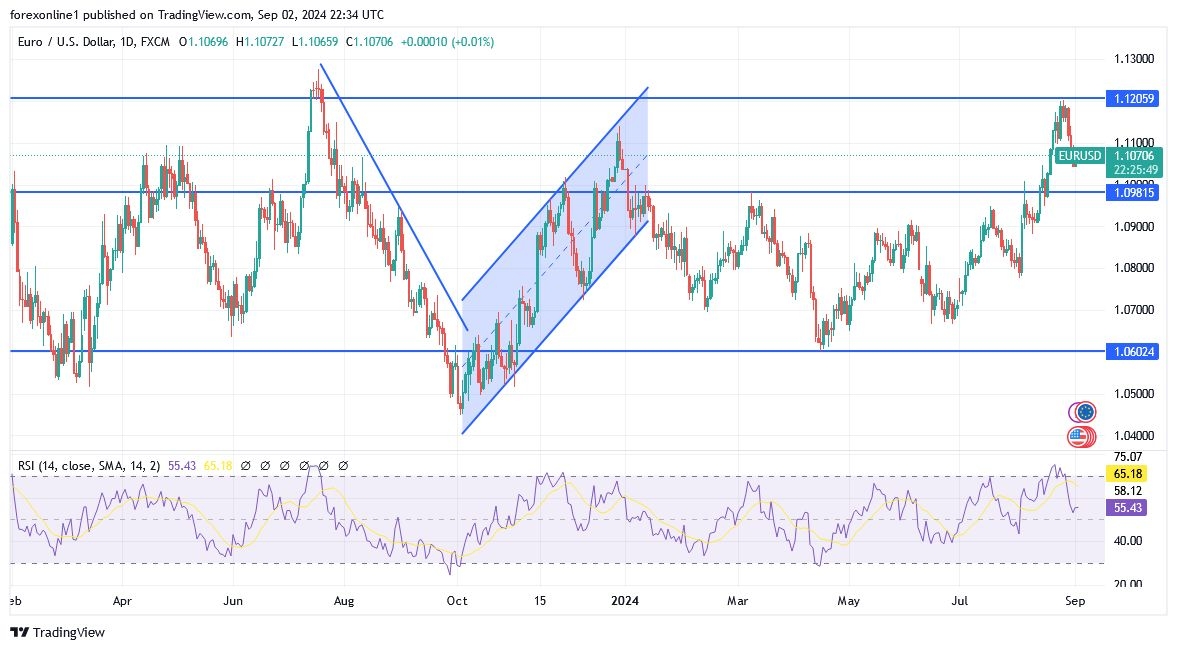- The euro was trading at around $1.10 at the beginning of September, hovering near levels not seen since mid-August.
- Traders bet that the European Central Bank would cut interest rates for the second time at its meeting on September 12.
- Overall, the chances of another cut in borrowing costs increased after preliminary figures showed that eurozone inflation fell to 2.2% in August, its lowest level since July 2021.
- Meanwhile, core inflation also fell to 2.8% after three months at 2.9%.
Currently, traders are betting on two or three more cuts by the ECB this year. Meanwhile, the eurozone manufacturing PMI confirmed that the manufacturing sector remained in contraction in August, weighed down by Germany and France.
Weekly Forecast for EUR/USD:
The upward trend of the EUR/USD seems to have entered a neutral phase, and we believe it could decline further this week. According to reliable trading platforms, the EUR/USD rose sharply in August, peaking at 1.12 last Monday. Moreover, this rise pushed it strongly into the overbought zone, and warning bells were officially sounded on the Relative Strength Index (RSI).
Top Forex Brokers
According to the rulebook, an RSI above 70 - which we saw at the beginning of last week - should decline, necessitating a decline in the exchange rate. This week's previous forecasts have acknowledged this and have proven to be accurate in signalling the peak. Therefore, we do not believe that retesting last week's highs is likely in the coming days. Also, we are more inclined to expect lower levels from here, with the $1.10 level coming back into play before a potential restart of the broader 2024 rally.
Ultimately, the duration and depth of the current decline will depend on US economic data this week, which will determine the size of the Federal Reserve's interest rate cut in September. Concurrently, a 25 basis point US interest rate cut in September has now been completely ruled out by the market, which explains the weakness of the US dollar in recent weeks. Selling accelerated due to the increasing likelihood that the first cut would include an unusual and unprecedented 50 basis point cut, given the evidence suggesting the economy is beginning to slow significantly.
However, we believe the likelihood of a 50-basis point cut may decline further in light of the stronger-than-expected US non-farm payrolls report on Friday. Obviously, it could strengthen the dollar and weigh on the EUR/USD pair.
However, we believe that the chances of a 50bp cut may decline further in light of the stronger-than-expected US non-farm payrolls report on Friday, which could boost the dollar and weigh on the EUR/USD pair.
Financial markets are expecting 163,000 jobs in August, up from 114,000 in July, a figure that was affected by Hurricane Beryl, which passed through Texas. In this regard, an analyst at HSBC, who sees the US dollar now looking relatively cheap compared to fundamentals, says that “the easing of expectations for a Fed rate cut should see the dollar regain some lost ground.”
Lars Moland, an analyst at Nordea Bank, says that Hurricane Idalia, which hit Texas on July 8, may have been the main reason for the July jobs figures to look so bad. He added, "We expect the recovery in this week's data to remove some of the recession fears." He explains that economic activity was also affected by Idalia as the national decline of 140,000 in housing starts in July can be traced back to the southern states, with no notable changes elsewhere.
Before Friday's jobs report, we will cover survey data in the form of the ISM Manufacturing PMI on Tuesday, which is expected to be at 47.5, up from 46.8. The ISM Services PMI will be closely watched on Thursday, with the market expecting a reading of 50.9 in August, down from 51.4. Strong PMI figures would make the dollar stronger ahead of the very important jobs report.
EUR/USD Technical analysis and forecast:
The EUR/USD pair has been forming higher lows, connected by a resilient uptrend line since mid-July. Technically, the price may test this support zone as it retreats to the nearby 38.2% Fibonacci retracement level. The price seems to be finding some buyers at current levels, coinciding with the dynamic pivot point of the 100-period simple moving average. The 100-period simple moving average is above the 200-period simple moving average, indicating that the stronger resistance path is upwards or that support is more likely to hold rather than break.
Therefore, the deepest retreat could reach the 50% level at 1.0993 or the 61.8% Fibonacci level closer to the dynamic support of the 200-period simple moving average at 1.0942. Also, the dividing line for an upward correction is the trendline near the key psychological level of 1.0900. Conversely, a continued rise could lead the EUR/USD pair back to its highest levels near the key psychological resistance at 1.1200 or higher. At the same time, the Stochastic indicator is already retreating into oversold territory, indicating exhaustion among sellers, so a shift to the upside would confirm the increase in upward pressure. The Relative Strength Index is also in oversold territory and is starting to turn upwards, so the price may follow suit as buyers return.
Ready to trade our daily Forex forecast? Here’s a list of some of the top forex brokers in Europe to check out.


